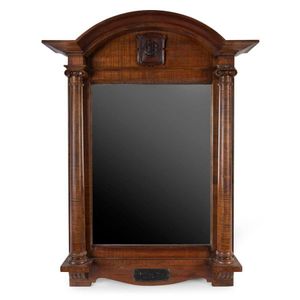CUB Honour Roll Mirror in Fiddleback Blackwood
You must be a subscriber, and be logged in to view price and dealer details.
Subscribe Now to view actual auction price for this item
When you subscribe, you have the option of setting the currency in which to display prices to $Au, $US, $NZ or Stg.
- Blackwood - One of the best known and most widely used Australian timbers, blackwood (acacia melanoxylon), is a member of the Acacia (wattle) family and grows in eastern Australia from about Adelaide in South Australia, as far north as Cairns in Queensland.
The largest, straightest and tallest trees come from the wet forest and swamps of north-west Tasmania where it is grown commercially.
Blackwood timber colours range across a wide spectrum, from a very pale honey colour through to a dark chocolate with streaks of red tinge.
The hardwood timber has been commonly used in the production of furniture, flooring, and musical instruments in Australia from the late 19th century. However, the straight grain timber is not the most prized or valuable, that honour falls to blackwood with a wavy, fiddleback pattern, which is used both in the solid and as a veneer. Fiddleback was only used on the finest examples of furniture. - Fiddleback - A name given to the pattern of the grain in some timbers, where the lines of the grain are compressed and at the same time wavy. Fiddleback grain is prized as a timber for furniture and musical instruments, and is expensive becasue of its scarcity.
In Australia fiddleback graining is found in blackwood. Other non-native timbers that are sometimes found with a fiddleback grain are mahogany and maple. - Circa - A Latin term meaning 'about', often used in the antique trade to give an approximate date for the piece, usually considered to be five years on either side of the circa year. Thus, circa 1900 means the piece was made about 1900, probably between 1895 and 1905. The expression is sometimes abbreviated to c.1900.
This item has been included into following indexes:
Visually similar items

A Regency overmantel mirror, circa 1820. The upper panel painted with en-grisaille panel of gambolling putti, with reeded cornice and pilaster form gilded gesso frame, 116.5 cm width x 154.5 cm height. Provenance: Purchased from Palmer Antiques, Sydney.

A mahogany bookcase embellished with ormolu mounts, French, 19th century, 82 cm high, 82 cm wide, 36 cm deep

Late Regency Cuban mahogany console table, c. 1830, on bold scrolled legs with carved acanthus leaf decoration, with two drawers in the frieze and platform base, height 94 cm, width 150 cm, depth 38 cm. Provenance: Fraser's Antiques, Willoughby, 1992

A French walnut 19th century armoire, the arched moulded cornice, above a mirrored door, flanked by canted corners, on block feet. 238 cm high, 108 cm wide, 41 cm deep.
